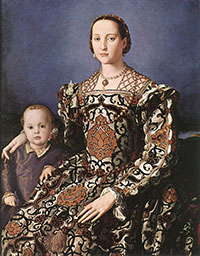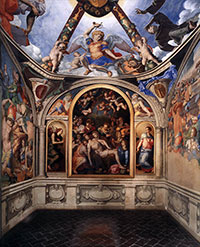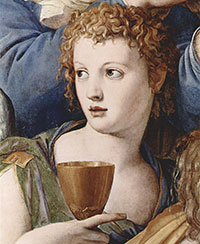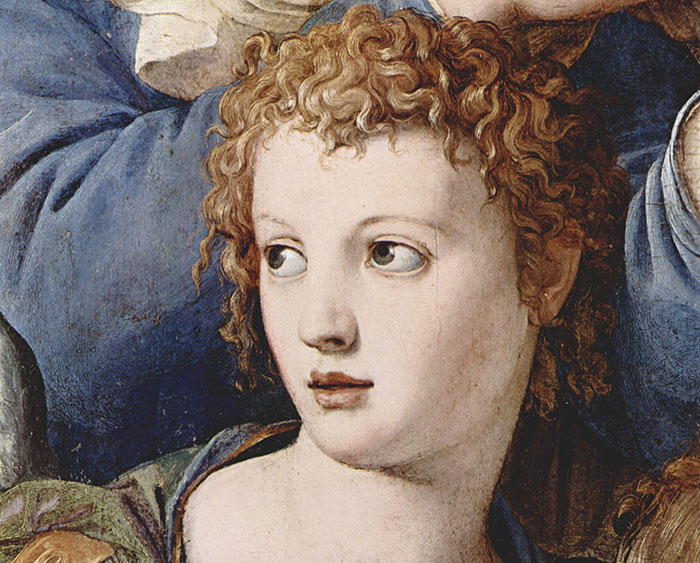 |
|
| I T N L |
Agnolo Bronzino, Cappella di Eleonora in the Palazzo Vecchio (detail), Florence (1540-45) |
Agnolo Bronzino |
| Agnolo di Cosimo (November 17, 1503 – November 23, 1572), usually known as Il Bronzino, or Agnolo Bronzino, was an Italian Mannerist painter from Florence. His sobriquet, Bronzino, in all probability refers to his relatively dark skin.[1] Life Bronzino was born in Florence, the son of a butcher. According to his contemporary Vasari, Bronzino was a pupil first of Raffaellino del Garbo, and then of Pontormo, to whom he was apprenticed at 14. Pontormo is thought to have introduced a portrait of Bronzino as a child (seated on a step) into one of his series on Joseph in Egypt now in the National Gallery, London.[2] Pontormo exercised a dominant influence on Bronzino's developing style, and the two were to remain collaborators for most of the former's life. An early example of Bronzino's hand has often been detected in the Capponi Chapel in the church of Santa Felicita by the Ponte Vecchio in Florence. Pontormo designed the interior and executed the altarpiece, the masterly Deposition from the Cross and the sidewall fresco Annunciation. Bronzino apparently was assigned the frescoes on the dome, which however have not survived. Of the four empanelled tondi or roundels depicting each of the evangelists, two were said by Vasari to have been painted by Bronzino. His style however is so similar to his master's that scholars still debate the specific attributions.[3]
Work |
Bronzino first received Medici patronage in 1539, when he was one of the many artists chosen to execute the elaborate decorations for the wedding of Cosimo I de' Medici to Eleonora di Toledo, daughter of the Viceroy of Naples. It was not long before he became, and remained for most of his career, the official court painter of the Duke and his court. His portrait figures—often read as static, elegant, and stylish exemplars of unemotional haughtiness and assurance—influenced the course of European court portraiture for a century. These well known paintings exist in many workshop versions and copies. In addition to images of the Florentine elite, Bronzino also painted idealized portraits of the poets Dante (c. 1530, now in Washington, DC) and Petrarch.
|
||
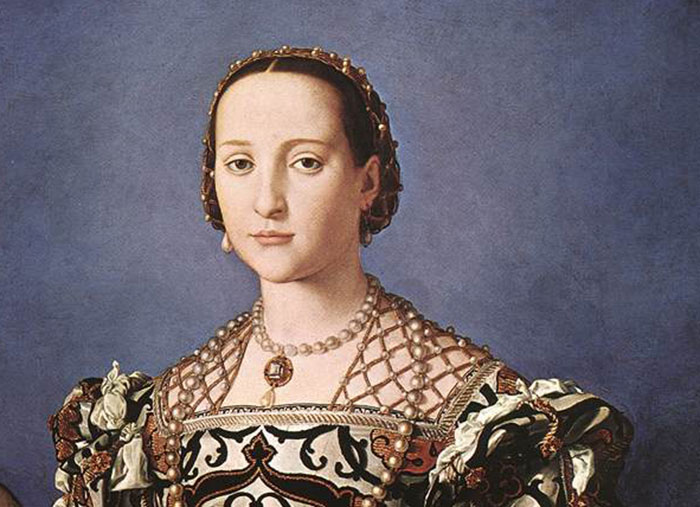 |
||
Eleonora of Toledo with her son Giovanni de' Medici; 1544-45, oil on wood, 115 x 96 cm, Galleria degli Uffizi, Florence
|
||
| Daughter of viceroy of Naples Don Pedro di Toledo, Eleonora married Cosimo I de' Medici in 1539 and died in 1562. In this picture, datable around 1545, she is portrayed with one of their eight sons, the young John, born in 1543 and died, as his mother of malaria, in 1562. The intense blue of the background and the stateliness of the figure enhance the preciousness of Eleonora's dress (for long time, erroneously believed her sepulture cloth), while her aristocratic beauty betrays a sense of melancholy. It was painted towards 1545, at the happiest moment of Bronzino's activity as a portrait painter. The diligent and frankly enjoyed description of the details of the costume are transfigured, through the geometrical simplification and the calm fixity of the light, into a vision of an almost ecstatic detachment. Archeological work in the tomb of Eleonora, the wife of Cosimo I de' Medici, has revealed fragments of the dress worn in this portrait.
|
||
|
||
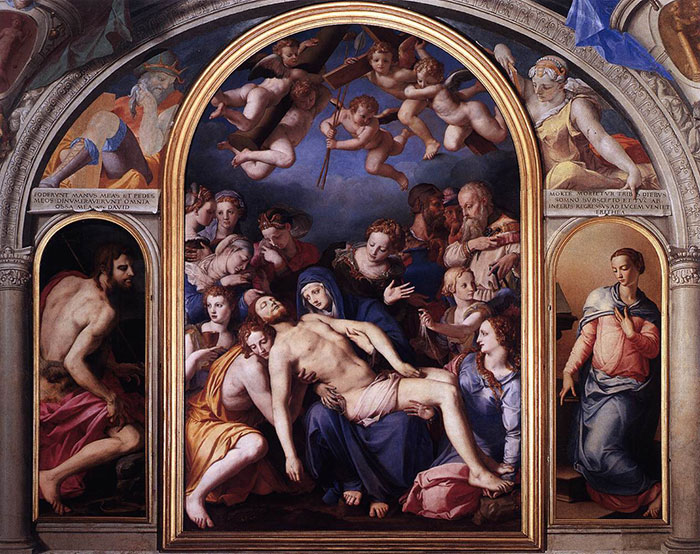 |
||
Agnolo Bronzino, Altarpiece, c. 1540, oil on wood, Palazzo Vecchio, Florence
|
||
|
||
The Crossing of the Red Sea occupies the whole left wall of the chapel called "of Eleonora of Toledo", in on second floor of the palace, which was frescoed by Bronzino for the Grand Duchess in 1540-1545. The Biblical scene is depicted with the use of large figures which, seen from very near, gives the impression of an icy splendour, corroborated by the vivid colours. Some of the figures are clearly inspired by Michelangelo or Pontormo, as well as by the ancient statue sculpture. In particular, the foreground man on the left is a reproduction of the bronze Idolino (now in the Archaeological museum of Florence). |
||
|
||
|
||
|
||
|
||
|
||
[1] Chilvers, Ian, "Dizionario dell'arte", ISBN 88-6073-115-1, Dalai Editore, 2008, p.179 Google book
Art in Tuscany | Art in Tuscany | Giorgio Vasari | Lives of the Most Excellent Painters, Sculptors, and Architects |
|
|||
Bibliography |
||||
|
This article incorporates material from the Wikipedia article |
||||
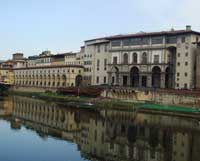 |
 |
|||
Vasari Corridor, Florence |
Panorama Sant’Angelo in Colle, Montalcino | Florence, Duomo |
||
|
||||
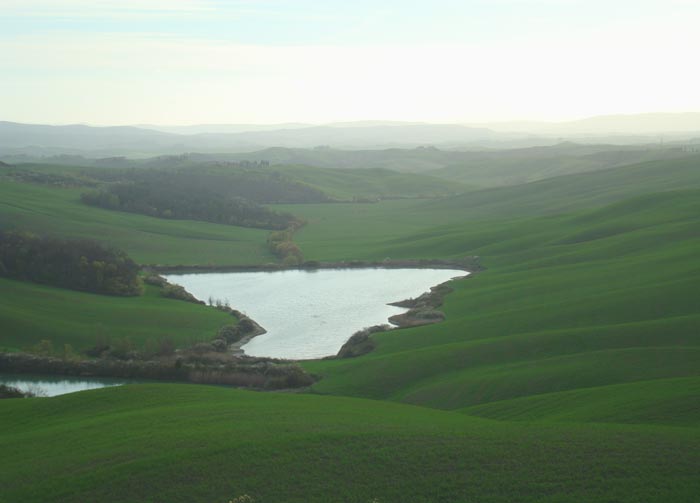 |
||||
Crete Senesi, surroundings of Podere Santa Pia |
||||
| Podere Santa Pia is located in south of the ‘Crete Senesi’, a beautiful clay hills landscape which is an ideal starting point to discover Tuscany. The guesthouse is located in Castiglioncello Bandini, a charming medieval village situated on a hill, which offers a spectacular view on the Valle dell’Ombrone and the Maremma. Montalcino, the abbey of Sant'Antimo, Pienza and the Crete Senesi with Asciano, Buenvonvento and the Abbey Di Monte Oliveto Maggiore are within easy reach. Florence is easily reachable from the main railway station in Grosseto or by bus (Paganico). With its gothic influences, Siena is often called the most beautiful city of Tuscany. This medieval city amidst the olive yards and the Chianti, consists of narrow streets and small squares. The city contains Toscana’s most photographed place, the “Piazza del Campo”. Twice a year, this square is the venue for the colourful “Palio”, a horserace wherein each ‘fantino’ (participant) competes for the honour of its ‘contrada’ (quarter). The Abbey of Monte Oliveto Maggiore, a large Benedictine monastery, is located 36 km south of Sienna and 10 km south of Asciano, in the characteristic "badlands" landscape of the Crete Senesi. The Olivetan community traces its foundation to 1313. The monastery is accessed through a drawbridge which leads to a medieval palace in red brickwork, surmounted by a massive quadrangular tower with barbicans and merlons. The Chiostro Grande ("Great Cloister") has a rectangular plan and was realized between 1426 and 1443. On the oldest side it has a two-storey loggia and a pit, dating to 1439. Under the vaults of the cloister are frescoes of the Life of St. Benedict painted by Luca Signorelli and il Sodoma, considered amongst the most important Renaissance artworks in Italy. The frescoes disposition follows St. Gregory's account of Benedict's life. Signorelli's paintings were executed in 1497-98, while Sodoma's date to 1505 afterwards. The church entrance is preceded, in the Chiostro Grande, by a frescoes with Jesus Carrying the Cross, Jesus at the Column and St. Benedict Giving the Rule to the Founders of Monte Oliveto, also by Sodoma. |
||||

